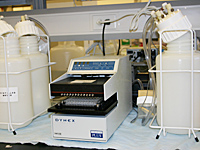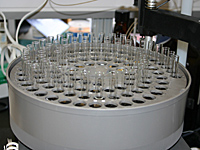Research
Infectious Diseases
Hepatitis B (HBV) and Therapeutic Vaccines
In addition to preventing infection (i.e. prophylactic vaccines), vaccines can be used to treat ongoing infections (i.e. therapeutic vaccines). This approach would be relevant in chronic disease such as HCV, HIV and chronic HBV infections. Worldwide, approximately 350 million people are chronically infected with HBV and nearly one-third of these individuals are expected to develop serious progressive liver disease. In the US there are approximately one million people chronically infected with HBV. Chronic hepatitis B can cause progressive liver inflammation that occurs when the immune system attacks hepatitis B virus infected cells. In chronic carriers, the immune system typically loses the ability to resist the infection effectively. Current antiviral therapies, which must be taken indefinitely at a cost of $2,000 per year, are aimed at interfering with viral replication to reduce the level of infection. This reduces the attack on the liver by the immune system. In a small number of patients, antiviral therapy is associated with viral clearance, suggesting that the chronic phase of this disease may respond to an immune enhancing therapeutic vaccine. Dr. Milich's team has, over the past 25 years, focused on researching the immune response to HBV and are therefore posed to effectively address the design of treatments.
Hepatitis C Virus (HCV)
The HCV is the predominant hepatitis virus in the US primarily because it often (85%) results in chronic life-long infections. Little is known about the mechanisms of persistence or the requirements for a protective immune response. Dr. Milich's group together with collaborators at the Karolinska, have published several studies in this area and are currently poised to continue the research related to vaccine development for this virus.
Influenza
A major problem with the development of flu vaccines is the constant mutations in the viral host proteins (i.e., H and N proteins), which generate a new serotype every year. We are working on an approach using a highly conserved region of a protein (the M protein), in conjunction with other technology to develop a vaccine which addresses this problem. Antibodies to the M protein have recently been shown to inhibit flu virus replication. However, a method of rendering the M protein B cell epitope highly immunogenic has been limiting. Our approach will address the issue of limiting immunogenicity. Dr. Milich's team has focused on developing an influenza vaccine.
Malaria
Given the very high burden malaria imposes on many developing countries, the overall objective of this proposal is to develop a P. falciparum malaria-specific immunogen that may be useful as an affordable and effective vaccine to prevent malaria. The current most effective malaria vaccine candidate (RTS,S/AS02A) is based on the use of a particulate carrier platform (the HBsAg) fused to malaria circumsporozoite (CS)-specific T and B cell epitopes. Current limitations of the RTS,S vaccine have been a requirement for reactogenic adjuvants and transient protection. A further potential complication is that the carrier is derived from a human pathogen, the hepatitis B virus (HBV). To circumvent these problems a non-human pathogen-derived carrier platform has been developed, specifically the core protein from the woodchuck hepadnavirus (WHcAg). The combination of these two powerful technologies, the WHcAg-carrier platform and the P. falciparum/P. berghei hybrid sporozoite challenge model, will enable the production of a variety of CS-WHcAg hybrid particle immunogens that can be tested for protective efficacy in an in vivo infectious model system specific for P. falciparum malaria. Dr. Milich's team is focusing on this technology.
Salmonella
Salmonella is a major pathogen of humans and of domestic and wild animals, causing major medical and economic damage. One type of Salmonella, Typhimurium, can colonize and persist in many different species. As of early 2008 there is no active NIH-funded project to identify new genes involved in host range in Salmonella. Such studies may be a key to battling this versatile pathogen. We will reveal potential new vulnerabilities of this pathogen that may lead to the design of new therapeutic strategies, and will provide principles for understanding other pathogenic relatives of Salmonella, such as E. coli.. To date, only a small fraction of its genome has been surveyed for genes that differ in their contribution to colonization of different hosts. This project is designed to determine which Typhimurium mutants are unable to fully compete with wild type during colonization of three vertebrate host species, selected for their phylogenetic diversity and known susceptibility to Typhimurium infection.
Non-Infectious Diseases
Prostrate Cancer
Prostate cancer is a prevalent disease among men in the United Sates. Current therapies are limited, and there is no successful treatment once tumor cells have spread to other tissues. Discovery of successful therapies is still a truly important challenge. However, identification of new targets for cancer therapy requires a thorough understanding of the molecular processes that lead to cell transformation. Recent studies have shown that transcription factor Egr-1 (Early Growth Response-l) is present at much higher levels in human prostate tumors as opposed to normal cells. An important result from J. Milbrandt's laboratory was that lack of Egr-1 expression significantly delayed the progression of prostate carcinoma in mouse models. However, there has been no study to directly assess the role of Egr-1 in tumor initiation or to measure the effect of specifically blocking Egr-1 expression in prostate cancer cells. These issues are critical and need to be tested before designing Egr-based therapies. Our approach is based on the rationale that blocking Egr-1 expression in prostate cancer cells will inhibit cell proliferation and eventually stop tumor growth. We describe the design and obtaining of specific antisense oligonucleotides that block Egr-1 function. . This is part of the on-going research of Dr. Baron and team.
Breast Cancer
A current stem cell hypothesis for breast cancer holds that mutations occur in the normal stem cell lineage from which the various differentiated cell types of the breast derive. These cancer stem cells divide asymmetrically, leading either to expansion of the stem cell population, or to differentiated daughter cells. According to this hypothesis, breast cancer arises when a combination of mutations and epigenetic modifications that subverts normal control mechanisms accumulate in one of the stem cell lineages. Intratumoral heterogeneity is implied by this mechanism because the mutations occur sporadically with respect to the growth of the stem cell population. The research team proposes to track the evolution of intratumoral genetic heterogeneity in single tumors, and use this data to model tumor development by means of oncogenetic trees.. This approach may lead to diagnostic and prognostic markers or therapeutic targets for different stages in progression. Only a small part of a breast cancer tumor is capable of causing metastatic disease, and these "cancer stem cells" are difficult to identify and characterize. By tracing the history of mutations as they develop and disseminate through the tumor, they will be able to identify diagnostic and prognostic markers, as well as potential therapeutic targets for progressively more aggressive forms of the disease. Dr. John Welsh and Dr. Borgstrom head this research effort.
A cancerous tumor is not only composed of tumor cells. There are numerous other types of cells such as fibroblasts, endothelial cells, and immune cells. These cells make up the stroma of the tumor. An important criterion in the treatment of solid tumors is the understanding of the molecular and microenvironmental events that influence tumor formation, growth, metastasis and vascularization. The objective of this research by Dr. Borgstrom and team is to clarify the role of tumor stroma and the genetic changes in stromal cells in the initiation and progression of breast tumors. The lack of adequate models that recapitulate the tumor microenvironment has significantly delayed advances in the understanding of the role of the stroma. However, they have developed a new tumor model that more accurately depicts human tumors in many ways beyond the standard subcutaneous models used predominately in the past.
Cancer Therapeutics
Serendipitously, harmless variants of Salmonella prefer to reside in tumors over any other location in the human body, by a factor of 1000 or more. This poorly understood phenomenon can result in tumor regression and cancer cures. VRISD is working to engineer Salmonella so that it can be used as a therapeutic and novel delivery agent for exogenous therapeutics in cancer. They use newly developed high-throughput tools to identify Salmonella promoters that are activated exclusively in tumors. The team is using these tumor-specific promoters to express cloned foreign therapeutic proteins only when bacteria reach tumors. In addition, they have developed tools to track thousands of bacterial mutants simultaneously, allowing them to identify mutants with favorable characteristics, such as those that accumulate most highly in tumors.
Home | About VRISD | News | Research | Publications
Careers At VRISD | How To Help | Contact Us
© VRISD 2006













